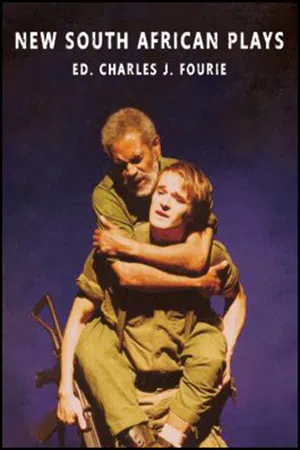
New South African Plays
- English
- ePUB (mobile friendly)
- Available on iOS & Android
New South African Plays
About this book
A collection of six plays dealing with the new South Africa, published in 2006 to celebrate 10 years of democracy post-apartheid. Plays about racial conflict, the impact of AIDS, power and corruption, the legacy of the past and female identity. Reprinted 2012, 2019.
The Plays
The Playground by Beverly Naidoo
"…it floats on a haunting, echoing raft of traditional South African harmonies that make watching it a joyful experience as well as a thought-provoking one…" Time Out Critics' Choice – Pick of the Year
Taxi by Sibusiso Mamba: Edinburgh fringe first winner
"a superbly written and produced play… A fine piece of work that's refreshingly free of cliches." Daily Mail, Pick of the Week
Green Man Flashing by Mike Van Graan
"…This finely crafted drama tears at the heart and soul of our democracy, and rips at the underbelly of corruption and political power through its astute writing…" Star Tonight
Rejoice by James Whylie
"… the cruellest irony of all is left until the end… the same one which has spelled the death of Rejoice… And millions more." Friends of BBC Radio 3
What the Water Gave Me by Rehane Abrahams
"tales that retrieve ancient magics and reveal contemporary terrors…" Cape Times
To House by Ashwin Singh: Finalist in the 2003 PANSA (Performing Arts Network of SA) Festival of Reading of New Writing (the country's foremost playwriting contest)
"To House is an important piece of theatre; in it people voice opinions that are uncomfortable and edgy. The cathartic and therapeutic value of hearing these things said aloud in a public place is part of our essential healing process and proves, once again, that art has the ability to go where angels fear to tread." Daily News, Durban
Frequently asked questions
- Essential is ideal for learners and professionals who enjoy exploring a wide range of subjects. Access the Essential Library with 800,000+ trusted titles and best-sellers across business, personal growth, and the humanities. Includes unlimited reading time and Standard Read Aloud voice.
- Complete: Perfect for advanced learners and researchers needing full, unrestricted access. Unlock 1.4M+ books across hundreds of subjects, including academic and specialized titles. The Complete Plan also includes advanced features like Premium Read Aloud and Research Assistant.
Please note we cannot support devices running on iOS 13 and Android 7 or earlier. Learn more about using the app.
Information
Table of contents
- New South African Plays
- Title
- Copyright
- Foreword
- Contents
- Introduction
- The Plays
- Useful links